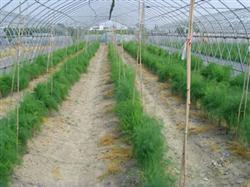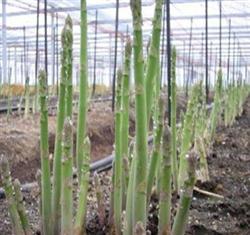How to grow pollution-free asparagus?

How to grow pollution-free asparagus? Please guide the method of pollution-free asparagus cultivation can refer to the following methods: first, variety selection selection of medium-ripe green and white asparagus varieties, such as Atlas, Apollo and other excellent varieties, these varieties have good quality, good flavor and strong adaptability. the general yield of green asparagus is 8-1000 kg per mu. Second, to raise seedlings, choose a high-lying, loose and fertile sandy soil as a seedbed, with a seedbed of 1.3-1.5 meters wide and 10 meters long per mu. Each seedbed is evenly mixed with 150-200 kg of mature organic fertilizer, 1 kg of calcium superphosphate and 1 kg of potassium chloride. After the soil and fertilizer are mixed evenly, a bowl maker with a diameter of 8-10 cm and a height of 10 cm is used to make bowls, which requires about 2500 bowls per mu. The field needs 50-70 grams of seeds per mu. After sprouting, one seed is sown in each bowl from March 10 to April 10. After sowing, the fine soil is 1.5-2 cm thick. The border is covered with plastic film, and then a small shed is set up. Before emergence, the temperature in the bed was controlled at 25-30 ℃ during the day and no less than 12 ℃ at night. When 70% of the seedlings were unearthed, the plastic film was removed and the seedlings were gradually ventilated. When the seedling age is 60 days, it can be planted with more than 3 tillers on the ground. Third, planting sandy soil and loam land with 3 kilometers around the planting land without pollution sources, good irrigation quality and low groundwater level. From the first and middle of May to the first and middle of June. Before planting, 2000-2500 kg of organic fertilizer, 4-5 kg of pure nitrogen, 4-5 kg of phosphorus pentoxide and 5-6 kg of potassium oxide were applied per mu. Deep ploughing and soil preparation rake flat, dig planting ditch, row spacing 1.3-1.5 meters, ditch width 40-50 cm, depth 30-40 cm. Open a set of ditches in the field and complete the three ditches. The distance between planting plants is 25-30 cm, and 1800-2000 plants per mu. After the seedlings gave birth to a new stem, the planting ditch was gradually filled in stages until the fish ridge was formed. Fourth, field management ⑴ weeding. According to the harm of weeds, ploughing and loosening the soil in time to eliminate weeds. ⑵ irrigation and drainage. During the growth period, if the weather is dry, it should be irrigated in time to prevent drought; the flood season or after heavy rain should be drained and waterlogged in time; ⑶ fertilization. Good application of "three fertilizers": budding fertilizer is generally combined with loosening soil between ridges in the first and middle of March, applying 2000-2500 kg of organic fertilizer per mu, 7-8 kg of pure nitrogen, 5-6 kg of phosphorus pentoxide and 5-7 kg of potassium oxide. Bamboo shoot fertilizer is usually in the first ten days of June. after leaving the mother stem in the field, 1500-2000 kg of organic fertilizer, 10-11 kg of pure nitrogen, 7-8 kg of phosphorus pentoxide and 8-9 kg of potassium oxide are applied per mu. Qiufa fertilizer was applied in late August and after bamboo shoots were stopped in the field, 2000-2500 kg of organic fertilizer, 10-11 kg of pure nitrogen, 6-7 kg of phosphorus pentoxide and 6-7 kg of potassium oxide were applied per mu. ⑷ cultivate soil and return soil. If white bamboo shoots are harvested, in late March every year, combined with ploughing and loosening the soil, the young bamboo shoots are cultivated into high ridges with a bottom width of 60 cm, a surface width of 30 cm and a height of about 40 cm, with loose inside and tight outside and smooth surface. After the combination of bamboo shoots, return the soil in time to restore the land leveling. ⑸ asparagus update. In general, 2-3 years after planting is asparagus juvenile, also known as root nurturing root; 4-5 years after planting is the peak of asparagus yield, which is called asparagus adulthood; asparagus harvest for 8-9 years is called asparagus aging period when the yield decreases gradually. After entering the aging period, new varieties should be selected in time, re-seedling transplanting or stubble cultivation. Click to get more asparagus planting techniques click to get more vegetable planting techniques
- Prev

How to fertilize asparagus seedlings?
How to fertilize asparagus seedlings? Please introduce the method that asparagus seeds must be affected by various diseases and insect pests in the process of development. Now I will teach you the fertilization technology of asparagus. I hope it will be useful to the bamboo shoot farmers! The cultivation of asparagus should use more organic fertilizer to make the soil loose and fertile, which is beneficial to the development of underground stem and root system.
- Next

How to identify asparagus stem blight?
How to identify asparagus stem blight? How to prevent and cure? Please introduce that asparagus stem blight is an important disease harmful to asparagus, which is common in various places. 1. Pathogen: Reed stem blight is a disease caused by fungal semi-knowledge subphylum mycelium. 2, symptom recognition: plant disease, damage to the stem and.
Related
- Where is it suitable to grow horseradish in China? it is expected to see the middle altitude horseradish in Alishan.
- How to prevent tomato virus disease reasonably? (Control methods included)
- Many people like to plant towel gourd on the balcony. What are the main points of this method and management?
- What crops can chili peppers be mixed with?
- Fertilization techniques and matters needing attention in Tomato
- What are the grafting techniques for peach seedlings in spring?
- Harm and control methods of root swelling disease of Chinese cabbage
- What are the pests of sweet potatoes? How to prevent and cure it?
- Symptoms, causes and Control methods of navel Rot in Tomato
- The cause of "Cucumber rotten bibcock" in Farmers' planting Cucumber and its Control Plan

